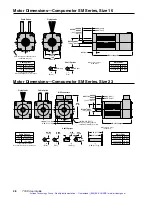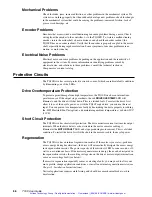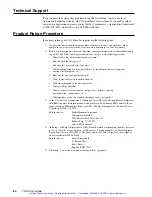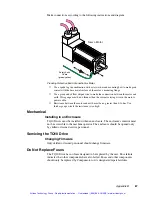
➃
Troubleshooting
5 9
Hall Miswiring
The drive will produce a motor fault and illuminate the red
MOTOR FAULT
LED if it
detects an improper Hall state on its Hall effect inputs (all HIGH or all LOW), or if no
motor is connected to the drive. A damaged Hall sensor can also activate the motor fault
protection circuit.
To diagnose Hall miswiring or a damaged Hall sensor:
➀
Remove AC power
➁
Disconnect I/O:
Disconnect all front panel inputs and outputs, except for enable input, motor
temp
±
, and Hall signals (Hall 1 – 3, Hall +5, Hall Gnd).
➂
Apply AC power
: If the
MOTOR FAULT
LED is still illuminated, then one or more Hall
sensors in the motor may be damaged.
➃
This can be verified with a volt meter or oscilloscope. Monitor the three Hall inputs at the
connector, relative to Hall ground. Slowly rotate the motor. A damaged, miswired, or
disconnected Hall signal will cause the “all HIGH” or “all LOW” state to occur at some shaft
position.
➄
Note that “open-collector” Hall outputs must be used. Contact factory if you must use
“differential” Hall-output motors.
Motor Overtemperature Protection
The TQ10 Drive has a circuit that can protect the motor against overheating. Through its
MOTOR TEMP+
and
MOTOR TEMP–
terminals, the drive checks for electrical continuity
provided by a normally-closed thermostat mounted on the motor. If the motor overheats
and the thermostat opens, the loss of continuity activates protection circuitry in the TQ10—
it turns off power output to the motor, and illuminates the
MOTOR FAULT
LED.
This is a latched fault. To resume operations, let the motor cool, then cycle power; or, with
the TQ10 Torque drive, you can use the reset input.
A motor overtemperature fault may be an indication that your motor is not sized properly
for your application. It may also indicate that your motor is not installed properly (poor
heatsinking, for example).
A thermostat cannot protect the motor in every situation!
Bursts of peak current produce
bursts of heat that are quickly absorbed in the motor windings, but slowly dissipated
through the motor case and mounting flange. If the bursts are short and infrequent, winding
temperature and thermostat temperature will be similar, and the thermostat can protect the
motor. If full current flows continuously in the motor, however, the windings can exceed
their rated temperature and be damaged, even before the thermostat temperature rises
enough to trigger a motor fault.
Artisan Technology Group - Quality Instrumentation ... Guaranteed | (888) 88-SOURCE | www.artisantg.com














































